| dc.contributor.author | Suhrke, Astri | |
| dc.contributor.author | Schmeidl, Susanne | |
| dc.date.accessioned | 2023-10-22T16:37:10Z | |
| dc.date.available | 2023-10-22T16:37:10Z | |
| dc.date.issued | 2023-06-01 | |
| dc.identifier | oai:www.cmi.no:8963 | |
| dc.identifier.citation | in Central Asian Survey vol. 42 no. 3 518-536 p. | |
| dc.identifier.issn | 1465-3354 | |
| dc.identifier.uri | https://hdl.handle.net/11250/3097928 | |
| dc.description.abstract | Nearly two years after the Taliban seized power in Kabul, in August 2021, the international aid community continued to search for workable approaches to deal with the new situation. Afghanistan’s deepening economic and humanitarian crisis called for major assistance, but the relationship between major donors and the Taliban de facto authorities had settled into a deeply adversarial mode. It resembled in many respects the relationship between the international aid community and the Taliban during the first Emirate (1996–2001). The story of that limited and difficult interaction – mostly consisting of humanitarian aid in a process that swung between confrontation and creative, though modest, compromises – is worth recalling for the insights it holds for the present. This article examines the patterns of that interaction, the results on the ground and the implications for the Western relationship with the present Taliban Emirate. | |
| dc.language.iso | eng | |
| dc.relation | Central Asian Survey | |
| dc.relation | 3 | |
| dc.relation.ispartof | Central Asian Survey | |
| dc.relation.ispartofseries | Central Asian Survey vol. 42 no. 3 | |
| dc.relation.uri | https://www.cmi.no/publications/8963-working-with-the-taliban-from-the-first-to-the-second-emirate | |
| dc.subject | Afghanistan | |
| dc.title | Working with the Taliban: from the first to the second Emirate | |
| dc.type | Journal article | |
| dc.type | Peer reviewed | |
| dc.identifier.doi | 10.1080/02634937.2023.2228346 | |
